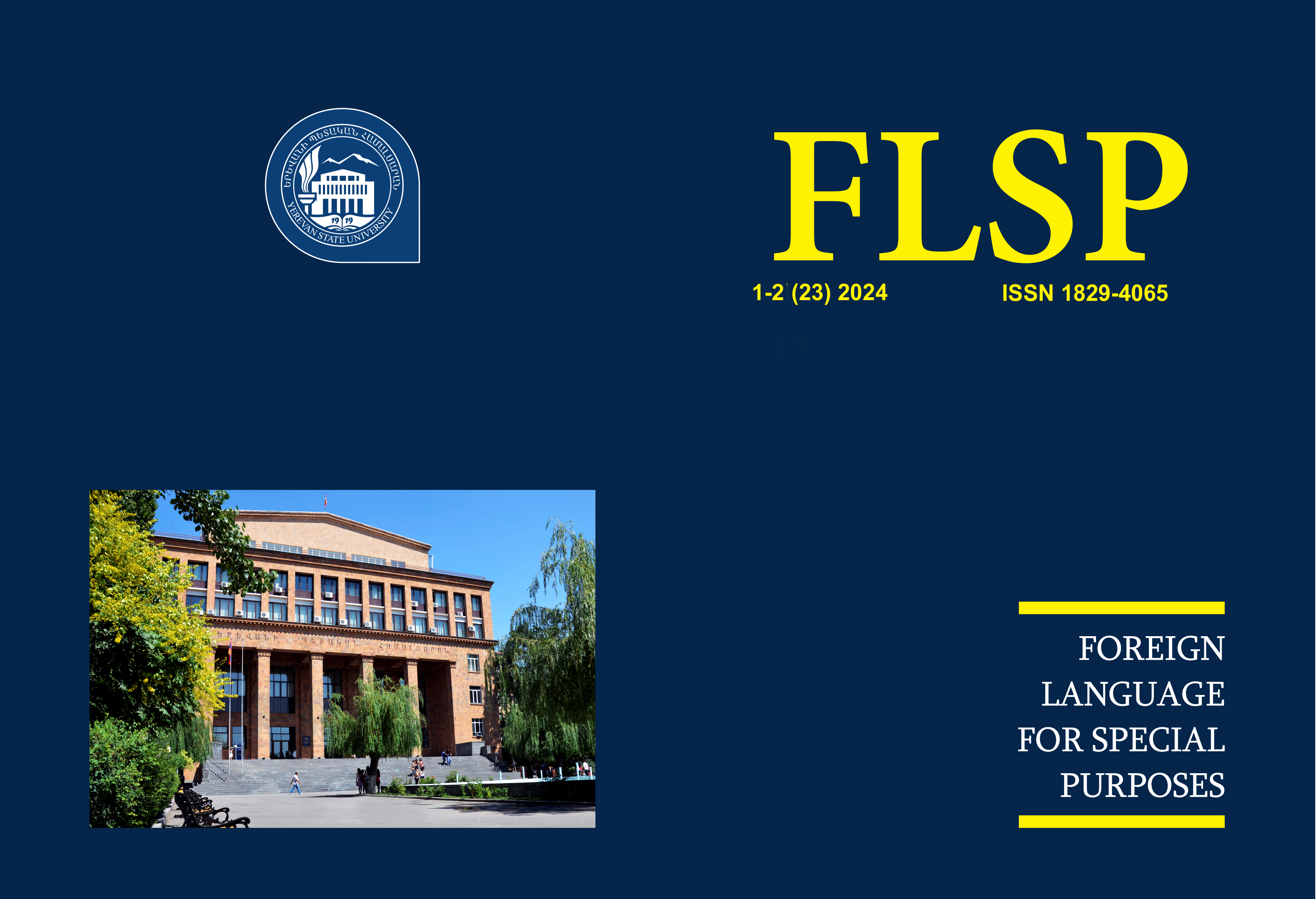ԽԱՂԱՖԻԿԱՑՈՒՄԸ ԵՎ ՈՒՍԱՆՈՂՆԵՐԻ ՄՈՏԻՎԱՑԻԱՆ ԱՆԳԼԵՐԵՆԻ, ՈՐՊԵՍ ՕՏԱՐ ԼԵԶՈՒ, ԴԱՍԱՎԱՆԴՄԱՆ ՀԱՄԱՏԵՔՍՏՈՒՄ
DOI:
https://doi.org/10.46991/flsp.v23i1-2.12185Keywords:
խաղաֆիկացում, մոտիվացիա, արտաքին մոտիվացիա, ներքին մոտիվացիա, անգլերենը, որպես օտար լեզուAbstract
Կրթության ոլորտում, այսօր ինպես երբևէ, մանկավարժների առաջնահերթ մտահոգությունը մնում է ուսանողների ներգրավվածությունը և մոտիվացիայի խթանումը, հատկապես անգլերենը, որպես օտար լեզու, դասավանդման համատեքստում:
Սույն հոդվածը ուսումնասիրում է խաղաֆիկացման ոլորտը՝ այն դիտարկելով որպես այս մարտահրավերներին դիմակայելու նոր մոտեցում: Այն նպատակ ունի ուսումնասիրել խաղային ուսուցման փորձառությունների մոտիվացիոն ազդեցությունները ավագ դպրոցում և բարձրագույն կրթական հաստատություններում՝ հաշվի առնելով ուսանողների կարիքները և առանձնահատկությունները, ինչպես նաև հնարավոր ռիսկերը: Հիմնվելով փորձագետների կարծիքների և հետազոտության արդյունքների վրա՝ հոդվածն ուսումնասիրում է խաղաֆիկացման հայեցակարգը և դրա հեղափոխական ներուժը՝ անգլերենը, որպես օտար լեզու, դասավանդման համատեքստում: Հոդվածն ուսումնասիրում է խաղային ուսուցման փորձառությունների հիմնական սկզբունքները, խաղաֆիկացման էությունը և դրա կիրառումը ուսանողների ներգրավվածությունը խթանելու գործում: Հիմնվելով խաղաֆիացման նախագծման տարրերի, առավելությունների և մարտահրավերների վերլուծության վրա՝ հոդվածն առաջարկում է խաղաֆիկացման՝ լեզուների ուսուցման վրա ազդեցության, համապարփակ ակնարկ: Հոդվածը անդրադառնում է նաև անգլերենը, որպես օտար լեզու, դասավանդման համատեքստում ուսանողների մոտիվացիան խթանելու և նրանց ներգրավվածությունն ապահովելու համար խաղաֆիկացման արդյունավետ կիրառման առանձնահատկություններին:
References
Bergmann, J., & Sams, A. (2012). Flip your classroom: Reach every student in every class every day. Eugene, Or: International Society for Technology in New York, NY Education.
Deci, E. L., Koestner, R., & Ryan, R. M. (2001). Extrinsic rewards and intrinsic motivation in education: Reconsidered once again. Review of Educational Research, 71(1), 1–27. doi:10.3102/ 00346543071001001
Deterding, S., Dixon, D., Khaled, R., & Nacke, L. (2011). From game design elements to gamefulness: defining “gamification.” Proceedings of the 15th International Academic MindTrek Conference: Envisioning Future Media Environments (pp. 9–15). New York, NY: ACM. doi:10.1145/2181037.2181040
Domínguez, A., Saenz-de-Navarrete, J., de-Marcos, L., Fernández-Sanz, L., Pagés, C., & MartínezHerráiz, J.-J. (2013). Gamifying learning experiences: Practical implications and outcomes. Computers & Education, 63, 380–392. doi:10.1016/j.compedu.2012.12.020
Eccles, J.S.; Wigfield, (2002). A. Motivational Beliefs, Values, and Goals. Annu. Rev. Psychol., 53, 109–132.
Elam, C., Stratton, T., & Gibson, D. D. (2007). Welcoming a new generation to college: The millennial students. Journal of College Admission. Retrieved from http://www.eric.ed.gov/ ERICWebPortal/contentdelivery/servlet/ERICServlet?accno=EJ783953
Glover, I. (2013). Play as you learn: Gamification as a technique for motivating learners. In: J. Herrington, A. Couros & V. Irvine (Eds.) Proceedings of World Conference on Educational Multimedia, Hypermedia and Telecommunications (Vol. 2013, pp. 1999–2008). Chesapeake, VA: AACE.
Harlen, W., & Deakin Crick, R. (2003). Testing and motivation for learning. Assessment in Education: Principles, Policy & Practice, 10(2), 169–207. doi:10.1080/0969594032000121270
Howe, N., & Strauss, W. (2003). Millennials go to college: Strategies for a new generation on campus. Washington, DC: American Association of Collegiate Registrars and Admissions Officers.
Kapp, K. M. (2012). The gamification of learning and instruction: Game-based methods and strategies for training and education. San Francisco, CA: John Wiley & Sons.
Kim, B. (2012). Harnessing the power of game dynamics why, how to, and how not to gamify the library experience. College & Research Libraries News, 73(8), 465–469.
Klopfer E., Haas J., Osterweil S., Rosenheck L. (2018). Resonant games: Design principles for learning games that connect hearts, minds, and the everyday, MIT Press, doi:10.7551/mitpress/10887.001.0001
Lee, J., & Hammer, J. (2011). Gamification in education: What, how, why bother? Academic Exchange Quarterly, 15(2), 146.
Maehr, M. L., & Meyer, H. A. (1997). Understanding motivation and schooling: Where we’ve been, where we are, and where we need to go. Educational Psychology Review, 9(4), 371–409. doi:10. 1023/A:1024750807365
McGonigal, J. (2011). Reality is broken: Why games make us better and how they can change the world. London: Penguin.com.
Nicholson, S. (2012, June). A user-centered theoretical framework for meaningful gamification. Paper presented at Games+Learning+Society 8.0, Madison, WI.
Фопель К., (2003). Технология ведения тренинга. Теория и практика. Пер. с нем. – М., 2003.
Downloads
Published
Issue
Section
License
Copyright (c) 2024 Lusine Madoyan

This work is licensed under a Creative Commons Attribution-NonCommercial 4.0 International License.
Creative Commons Attribution-Non-Commercial (CC BY-NC). CC BY-NC allows users to copy and distribute the article, provided this is not done for commercial purposes. The users may adapt – remix, transform, and build upon the material giving appropriate credit, providing a link to the license. The full details of the license are available at https://creativecommons.org/licenses/by-nc/4.0/

